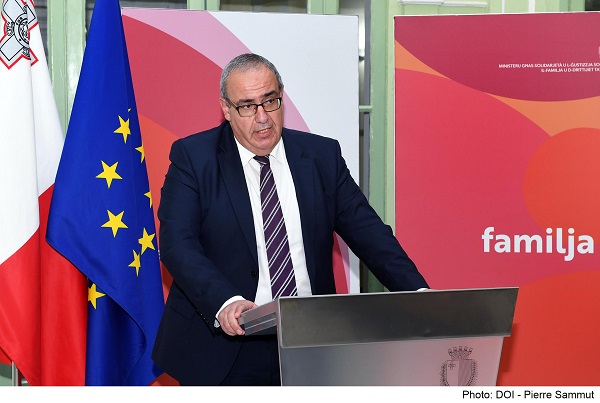Expenditure for Social Benefits for 2020 exceeds one billion Euro
For the first time in our country, a historic milestone in the social area has been set, after the global expenditure in social security benefits has exceeded one billion euro. The total expenditure reached was one billion, seventy-seven million euro (€1.077bn).
Statistics published by the National Audit Office shows that expenditure during 2020 increased by nearly €79 million from the previous year. The greater part of that sum being €67.4 million in contributary benefits including pensions, for which expenditure exceeded €878 million.
During a press conference Minister Michael Falzon announced this achievement with satisfaction while also stating that this constitutes a clear example of the proper practice of social solidarity and social justice.
“I feel privileged to form a part of this endeavour: a part of this government which is truly a government of the people, for the people. A government which is constantly seeking to incentivise rather than tighten the purse strings or creating austerity measures. This is the reason why we have the trust of the people and this also further encourages us to carry on with our work and assist families, most especially in these moments of extreme difficulty.”
Minister Falzon recalled how eight years ago this government faced Excessive Deficit Procedure” and rather than burdening the people, it succeeded in creating incentives with the main purpose of “Making Work Pay” with measures such as In-Work Benefit and Tapering of Benefits.
During this conference the Permanent Secretary of the Ministry Mr Mark Musu’ held a presentation giving a detailed account of the social measures which were additionally enhanced and which reached even further people.
The global expenditure on social benefits
As seen in Table 1, the global expenditure in social benefits including pensions between 2013 and 2020 increased by nearly €263m , with an average of €38m each year. 2020 marked the greatest annual increase ever registered in social expenditure, that is €79m which is an increase of more than twice as much as previous years.
Table 1 – Global annual expenditure on social benefits 2013-2020

The expenditure in the social area in 2020 also included the payments of four special benefits which were launched at the beginning of the pandemic in March. Three of these benefits were designed to assist parents who had to stay at home to care for children under the age of 16, as well vulnerable persons or persons with disabilities who had to stop working. The fourth benefit was paid to persons who lost their employment due to the pandemic. A total of €14.5 million were paid to 8,794 people half of which were parents.
Pensions
Despite this additional expenditure, expenditure for 2020 would have still exceeded the norm. In fact almost three-quarters of the total expenditure in social benefits was paid to approximately 96,000 pensioners in receipt of retirement, invalidity, widow’s and non-contributary age pensions. These received over €791 million, a sum which shows an increase by over Є47 million over the previous year. Although there was an increase of 2,500 pensioners from the previous year, the greatest factor in this increment was the increase of Є7 per week for all pension rates.
As per Table 2, the global expenditure in pensions between 2013 and 2020 increased by 39% from Є570 million to Є791.5 million.
Table 2 – Global expenditure on pensions 2013-2020

This increase was driven mainly by expenditure in retirement pensions (+€187m) and widow’s pensions (+€35m). There was also an increase in the expenditure for non-contributary pensions, this was also because in recent years these have increased as have other pensions although invalidity pensions have diminished since those in receipt of invalidity pension have decreased in recent years.
Table 3 – Number of pensioners by year 2013-2020

* Numbers in Table 3 include all those who receive one of the mentioned pension throughout the year. The figures quoted also include those who died throughout the year and those who began to receive a pension instead of another one.
Table 3 shows that the number of pensioners between 2013 and 2020 increased by nearly 14,000 to 96,298. The greatest increase was in the number of retirement pensions (+14,027) followed by an increase of 1,677 in those in receipt of widow’s pension. There was also a decr4e4ase in the number of those in receipt of invalidity pension and a small reduction in those who receive age pension.
Non-Contributary Assistance
With regards to non-contributary benefits and assistance, there was an increase in expenditure in non-contributary benefits of €11.63 million when compared to 2019 thus reaching €198.7 million. This was due to the implementation of various budget measures throughout the year including new benefits as well as an increase in rates or criteria of eligibility for other benefits. In some cases the number of beneficiaries for some benefits was also increased.
An increase of nearly €5 million in disability assistance was registered, due to an increase in the number of beneficiaries but mostly because of the implementation of the last phase of the Reform of the Assistance for Disabled Persons which commenced in 2017. This reform included the introduction of increased severe disability assistance which was conceived for those persons who absolutely cannot work. The weekly payment was increased gradually and as from 2020 it reached the same level as the net national minimum wage.
The total expenditure in disability assistance rose to €31.5 million, this also includes the disabled child allowance and the visual impairment assistance. A total of 6,500 persons including children benefitted from this assistance.
The bonus of €300 to all those families who bore a child or adopted a child is a newly introduced non-contributary benefits expenditure. Such benefit is paid so as to assist these families with their new expenses. Around 300 families have received this benefit in 2020.
Another benefit which saw a growth in expenditure was that of the In-Work Benefit. This was due to the payment for the special supplement of €250 which was paid to each family which was entitled to this benefit in 2020 as well as a result of the increase in the rates paid to the parents of each child under the age of 23. In total 5,337 families were paid over €6.5 million. When the In-Work Benefit was launched in 2015 the number of beneficiaries was 1,359 and these were paid over a million euro (see table below).
The reduction on social dependency
While the increase in expenditure was taking place, there was a reduction in expenditure on social assistance as well as a reduction in unemployment assistance for the seventh consecutive year. The expenditure incurred on the two types of assistance in 2020 was just over €25 million- a significant reduction of nearly €37 throughout the past seven years, as shown in Table 4 below.
Table 4 – Expenditure on Social Assistance 2013-2020
| Social Assistance | Unemployment Assistance | |
| €’000 | €’000 | |
| 2013 | 36,582 | 22,861 |
| 2014 | 39,258 | 22,454 |
| 2015 | 28,454 | 17,901 |
| 2016 | 27,910 | 10,293 |
| 2017 | 26,812 | 6,005 |
| 2018 | 24,522 | 4,664 |
| 2019 | 22,410 | 3,886 |
| 2020 | 21,521 | 3,696 |
Sors: NSO
The above table illustrates that expenditure on social assistance decreased by over 41% or €15m, expenditure on unemployment was reduced by 84% or €19m. The reduction in expenditure on social assistance is due to the huge decrease on social assistance dependency thanks to the measures undertaken during a climate of economic growth where more people were spurred to join the workforce.
Table 4 shows how the number of beneficiaries receiving social assistance in 2020 still decreased despite the social and economic hardship brought about by the pandemic, while those receiving unemployment assistance remained the same as the previous year.
It is even more notable that as shown in Table 5, since 2013 there has been a significant reduction of over 50% or 4,643 persons in receipt of social assistance while those receiving unemployment assistance decreased by 82% or 5,012 persons. In total those receiving social assistance decreased to nearly 63% or 9,655 persons. A positive feature highlighted by these figures is that while the number of persons receiving tapering of social assistance is now decreasing as the period of 3 years during which they continued to receive this assistance is coming to a close, these same persons are not falling back on social assistance but are remaining in the workforce.
This is also reflected by the fact that the number of persons in receipt of In-Work Benefit has continued to increase so that in 2020 there were 5,337 families who received this benefit.
Table 5– Social Dependency 2013-2020

Click here to view excerpts from the Press Release.






